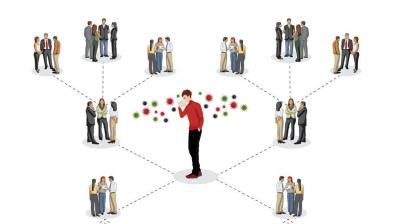An international research study has confirmed the effectiveness of protective masks against the transmission of COVID-19 through speaking, coughing, or sneezing. The study, conducted by a research team from Italy, Austria, and Sweden from the Universities of Padua, Udine, Vienna, and Chalmers, and published in the British journal "Journal of the Royal Society Interface," proposed a model for quantitatively measuring the risks of COVID-19 infection based on the distance between individuals, environmental conditions such as temperature and humidity, and the type of respiratory event (speaking, coughing, or sneezing) with or without the use of masks. The model confirmed that wearing a mask makes the risk of infection "practically negligible," according to the Italian news channel "Sky TG24."
The study showed that when speaking without a mask, infected droplets can reach over one meter, while coughing can spread them up to three meters, and sneezing can extend to seven meters. However, using protective masks minimizes the risk of infection whether speaking, coughing, or sneezing. It should be noted that viruses such as SARS-CoV-2 are transmitted from an infected person to a healthy one through droplets emitted during speaking, coughing, or sneezing. These suspended droplets can settle on surfaces, making them a transmission ground once touched by a healthy individual. In such cases, the infection chain can be countered by disinfecting surfaces and hands.
From the assessment of infection risks, it is clear there is no "universal" safe distance, as it depends on environmental conditions, viral load, and the type of respiratory event (sneeze, cough, or speak). For instance, during coughing (with average viral load), there can be a high risk of infection within a distance of two meters under average relative humidity, while it increases to three meters in high relative humidity conditions. Professor Francesco Picano from the Department of Industrial Engineering at the University of Padua stated that the COVID-19 pandemic has highlighted the importance of accurately modeling the transmission of the virus propelled by saliva droplets emitted by infected individuals during speaking, coughing, and sneezing. He added, "In our work, we reviewed current theories using the latest knowledge about respiratory aerosols, leading us to define a new model for estimating the risks of direct respiratory infection."




